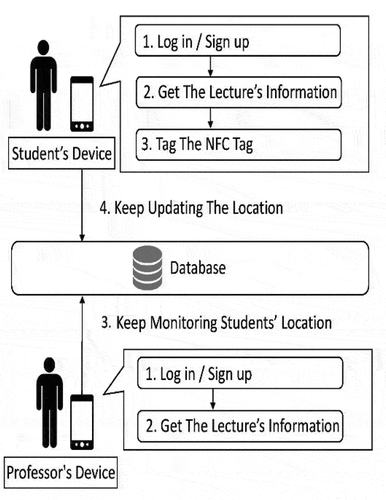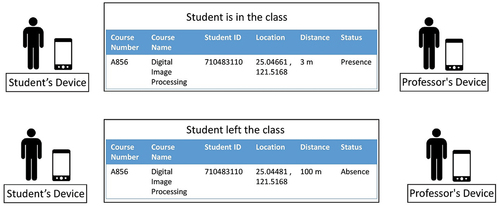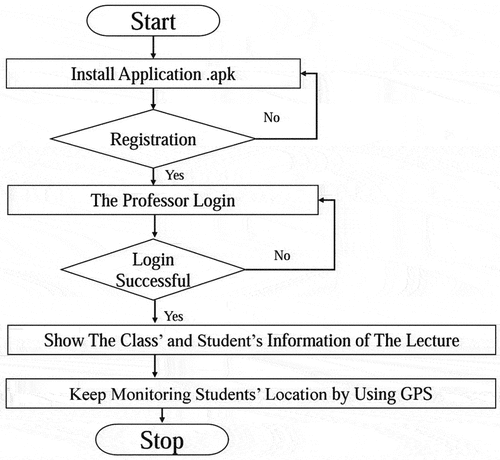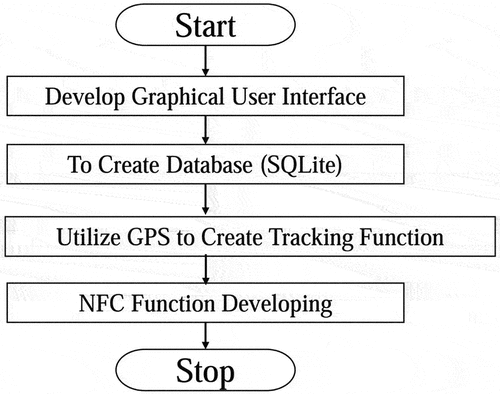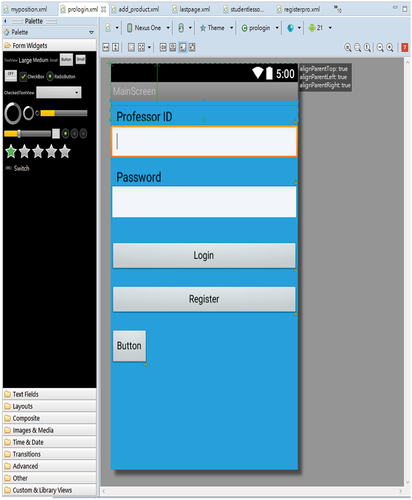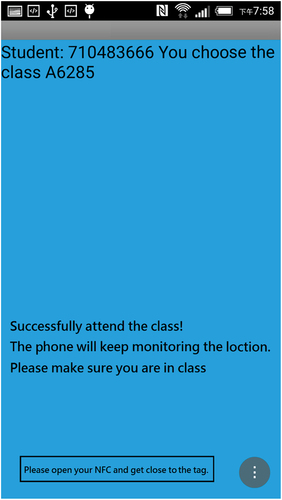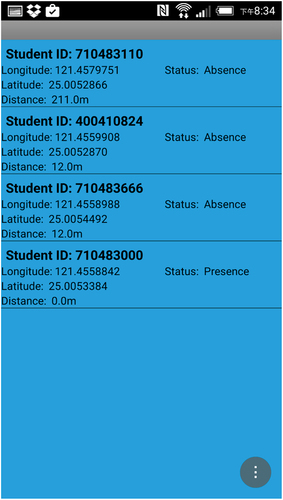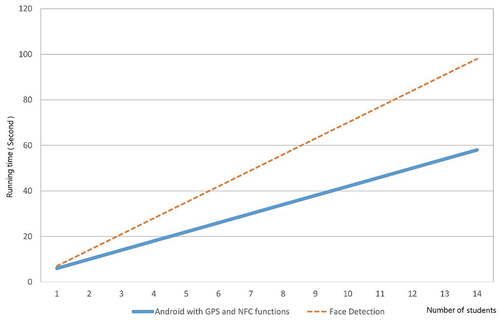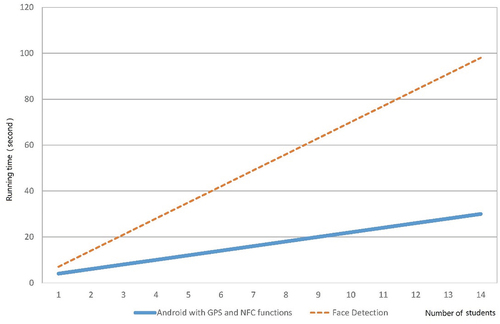 ?Mathematical formulae have been encoded as MathML and are displayed in this HTML version using MathJax in order to improve their display. Uncheck the box to turn MathJax off. This feature requires Javascript. Click on a formula to zoom.
?Mathematical formulae have been encoded as MathML and are displayed in this HTML version using MathJax in order to improve their display. Uncheck the box to turn MathJax off. This feature requires Javascript. Click on a formula to zoom.ABSTRACT
As usual, if many students are attending the lectures, their attendance tracking may become time consuming. Furthermore, there are some possibilities that students could cheat the lecturers of their attendance in the classroom. Therefore, a reliable method to manage the attendance tracking has become a critical issue. This paper aims to propose an attendance tracking system using an Android smartphone equipped with Global Positioning System (GPS) and Near Field Communication (NFC) technologies. Lecturers and students can constantly connect with one another by using smartphones to check and show their attendance automatically if they download and install the software Application (App). Finally, the experimental results have shown that our proposed system can successfully reduce some time for tracking students’ attendance. It also allows users to use their own Android smartphones without purchasing other electronic devices.
Introduction
Advances in smartphone hardware and software technologies not only made the teaching task easier for teachers, but also helped students learn some subjects more efficiently in and out of class. Nevertheless, student attendance tracking is still one of the most pressing issues for professors. With the huge popularity of smartphones, many studies have emerged on comparing those elements such as the system security and reliability of two most famous mobile platforms, iOS and Android (Strnadelova, Halamova, and Kanovsky Citation2019). One method to solve the problem of tracking attendance on the Android platform was previously proposed in reference (Noor et al. Citation2016).
Student attendance is an important issue in all universities. Students in class usually complain that the conventional method of tracking attendance leads to the loss of their rights to be educated due to time inevitably wasted in the checking process. On the other hand, professors who need to follow the course syllabus on schedule are also concerned about more time taken to call each student by name. Furthermore, professors are aware that students leave class during lecture hours or find other ways to falsely track their attendance (Mittal et al. Citation2016).
However, it is still possible for students to be able to fake their attendance, and the existing approaches are unable to avoid these unusual cases. For example, some students come to class after ensuring their professors who have marked their attendance, and then they leave the classroom during lecture hours without asking for permission. Of course, this unusual case should be prohibited (Kamaraju and Kumar Citation2017). Thus, professors need a reliable and more efficient system to solve this problem and stop the unusual case. It is unnecessary to call each student’s name from the list continually throughout the lecture hours, and then professors can manage the student attendance more efficiently.
Therefore, this paper aims to develop a student attendance tracking system, which not only makes sure that students come to class by checking their identification, but also constantly monitors their locations using Global Positioning System (GPS) and Near Field Communication (NFC). For achieving the goal of solving the attendance tracking problem, the proposed system is environmentally friendly because it is paperless (Nguyen and Chew Citation2017). Because a peer-to-peer mode is applied, the data exchange works in both directions between two mobile devices communicating with each other via NFC. Common applications (Apps) are used to exchange contact information (vCard) between two smartphones. Hopefully, less equipment is needed to reduce some time taken to track students’ attendance. However, the cheating problem is assumed to be eliminated, for instance, if a student lends his/her smartphone to a colleague, or if someone else is using another person’s smartphone during the lecture hours.
The rest of this paper is organized as follows: Section 2 reviews the GPS, NFC, and the related works. The overview of our proposed system and methodology are described in Section 3. The experimental results are presented in Section 4. Section 5 remarks the conclusion with possible research areas for future system development.
Literature Review
In this Section, some fundamentals regarding global positioning system (GPS), near field communication (NFC), and the related works are presented.
Global Positioning System
The GPS technology uses a receiver to get the geolocation and time information of devices via satellites. Using the unobstructed line of sight of more than four GPS satellites, we can obtain devices’ location accurately anywhere on the earth (Shi, Sim, and Lee Citation2017). Recently, people can receive GPS information from smartphones with an advantage in creating the indoor positioning system. For example, one App, called Travel Portal, relies on GPS and Geo Tagging to create a system where people can manage their trips in synchronization with travel agencies and answer the travel queries (Fridman et al. Citation2016). Another App focuses on children’s safety by tracking their location through GPS on the Android device (Maryam et al. Citation2016; Sunehra, Priya, and Bano Citation2016). Meanwhile, both stand-alone GPS devices and smartphones with GPS technology work by detecting the position and signals from a series of satellites set up by the US military. The devices calculate their position by reference to these satellites (Walkhighlands Citation2021).
In addition, AGPS (Assisted Global Positioning System) was also used for indoor positioning. It is important to underline that the indoor environment has problems with GPS/GNSS (Global Navigation Satellites System) positioning. These problems are reduced by some satellites recently, allowing the visibility of the constellation even in rooms with average windows (Hay, Duffy, and Whitfield Citation2017). GNSS positioning would be generally possible also in concrete buildings. Practically, GNSS signals may be detectable at some places in a concrete building, but it is generally agreed that the current smartphones cannot reliably receive and decode GNSS signals inside a multi-story concrete building.
Furthermore, four satellites are used to have the three-dimensional position, if instead the two-dimensional position is enough, three satellites are enough. Most GPS/GNSS Apps installed on the cellular terminals (for example, all road navigation systems) work with two-dimensional positions that allow positioning even with poor coverage (Faustmann et al. Citation2020). It describes a system with selective repeaters, which imposes the need of installing and adjusting infrastructure. While a mobile phone could not provide positions more accurate than five meters. This potentially allows one to accurately verify whether the student is really in the classroom or in the library next door.
Near Field Communication
The NFC technology is one of the methods being used to exchange datasets in many scenarios. It is a standard which covers communication protocols and data exchange (Mohandes Citation2015). Since our proposed system includes the implementation of NFC technology on Android devices as one of the functions to help students confirm their presence. Another related paper about using NFC on Android devices has been published to reduce working time and to increase their productivity.
Many papers have focused on the NFC technology for face recognition used on Android smartphones as a tool for validating identification (Rana and Ciardulli Citation2017). The App helps users tag the NFC to immediately validate the users’ identity when they are in danger or in emergency. It could be used in many scenarios, e.g., healthcare, public transportation, and neighborhood surveillance.
Furthermore, the NFC technology has a potential function to be implemented in the attendance tracking system as there is a method of applying the Android device Nexus7. It needs to have the lowest energy cost among all tablets, and to let students confirm their attendance with ease (Sousa and Barata Citation2020). However, when using the previous methods, students could easily cheat and leave class without asking for permission, and they would still have their presence recorded on the students’ attendance sheet. This study presents the best option to prevent this unusual case from occurring.
Related Works
There are many methods to check the student attendance, including fingerprint biometrics (Mittal et al. Citation2016), high real Zigbee (Kamaraju and Kumar Citation2017), RFID (Nguyen and Chew Citation2017) and face detection (Rekha and Ramaprasad Citation2017; Varadharajan et al. Citation2016). The fingerprint biometric system uses a fingerprinting device to accurately identify people’s identity. Maddu Kamaraju, et al. proposed a method based on high real Zigbee to save time in recording students’ attendance (Kamaraju and Kumar Citation2017).
With the popularity of smartphones in recent years, numerous Apps have been developed to help people solve a wide range of problems (Anjana, Nappinnai, and Sahari Citation2016). Especially, in the educational sector, there are many proposed systems which use the iOS or Android platform to help students learn some knowledge from the lectures more effectively (Douglas, Mazzuchi, and Sarkani Citation2020; Faustmann et al. Citation2020; Hay, Duffy, and Whitfield Citation2017; Koubaa, Boukattaya, and Damek Citation2018). By using the Android-based indoor positioning system, one App used the phone camera to scan the barcodes on students’ ID cards for identifying students (Kamaraju and Kumar Citation2017).
Another system was developed on Android which allowed students to use their mobile devices, or teacher’s terminal devices, registering their attendance as well as using a BLE (Bluetooth Low Energy) beacon to transmit a magic number to prevent students from cheating at registration time (Noguchi et al. Citation2018). Although these papers present some methods for checking students’ presence, they cannot still avoid the possibility that students might leave class after registration.
Proposed Attendance Tracking System
In this Section, the details in our system development are explained. We require GPS- and NFC-enabled Android devices to help students confirm their presence and allow the professor’s phone to keep monitoring students’ location until the lecture is over. In the App development part, we used Android SDK tools and Eclipse that fully supported our present system development. The reason why we selected the Android operating system is because of the rapid growth of smartphone users. It is reasonable to expect that all the students in class have their own smartphones, as would the professors do.
System Requirements
The presented App system aims to help the educational systems in colleges become more effective and productive. The student attendance tracking system uses smartphone devices based on the technological trends over the last few years. Many people use smartphones, not only in Taiwan but also everywhere in the world. In the universities of Taiwan, professors sometimes ask students to do research in class by using their smartphones. Expecting each one to have an Android smartphone, we have designed the methodology based on the Android device with GPS and NFC. After the system requirements are specified correctly, the system design is performed, and then the system implementation is finished.
System Development
This paper presents a student attendance tracking system using the Android smartphones with GPS and NFC. Users only need to download the App on their smartphones without purchasing other hardware systems. By referring to the system architecture, as shown in , we can view the system which consists of Android Apps and the server with a database system. They are both connected with a software system, one NFC tag, and an Android smartphone in hardware requirements.
When using this system, students and professors first need to download and install the App. The users are required to use their staff ID card or student ID card to sign up the App before they login. The Android phone can read the information from the chips, and the system can check the users’ identification. Both students and professors can access the information from the lectures. At this time, students are asked to tag the NFC to register their attendance in class. The students’ Android devices automatically upload their data items to the attendance sheet in the database system. After successfully uploading the students’ present attendance, the students’ phones continually update their locations in the database system, and the professor’s phone tracks students’ attendance statuses throughout the lecture hours.
As shown in , professors collect the information from the database system. If the distance between professor and students is less than a preset value, e.g. 10 meters, based on the size of the classroom, the App displays students’ status as “Presence.” However, if the distance is larger than 10 meters, the App turns the status into “Absence.” The diagram shows that the App uses GPS to help the professor monitor students’ locations in this system. In the monitoring step, the App on the students’ phones keep updating the location through the GPS. The App also updates the online database system. The online database system is composed of one table which is used to store those data items such as the students’ and professor’s username, password, ID number, course number, course title, and the distance between students and professor.
Database System Development
The App gets data items from the table. It can calculate the distance between students and professor on the table automatically, including Pid, Student ID, Longitude, and Latitude Distance. shows students’ personal data items, including student ID, longitude, latitude, create time and update time. These data items are updated once they finish logging in the App and tagging the NFC. Create time is not changed because the time is created at the time shown. As the first column shown, Pid is a primary key. The primary key cannot be the same as in other rows. It is used to identify and find out every student’s row of data items selected.
Table 1. Students updating the database using smartphones
shows that professors use the App to get information from the database system. This App is designed to automatically calculate the distance between professor’s smartphone and students’ ones. As this paper uses the Haversine formula (refer to EquationEq. 1(1)
(1) ) (Liu et al. Citation2020), the distance (d) between two phones is obtained by calculating two longitudes and latitudes which we’ve gotten, where
and
denote the latitudes of two points;
and
denote the longitudes of two points; and
denotes radius of the sphere. Finally, the professor obtains the distance. If the distance is larger than 15 meters, the status in the table is updated as “Absence.” If the distance is less than 15 meters, the status on the table is updated as “Presence.”
Table 2. Professors getting the information from database system
User Navigation Development
The App in the present system plays a critical role. Each flowchart is explained stepwise and from figure to figure. In the student’s phase, as shown in , students need to download and install the App. When students launch the App, they are guided to the sign-up/login page. If students want to sign up, they are supposed to use their student ID. After they sign in successfully, the App guides them to the course information page. Students can check the course information in this page and choose the course they want to take. Once they have chosen the course, the App asks them to confirm their attendance with the NFC tag. Then the App continues to update the location for the professor until the lecture is over. There is no limit to the number of NFC tags. The professor can provide more than one tag to help students activate the NFC tag quickly, so they do not need to wait in queue. The more NFC tags the professor provides, the quicker the students can go through the entire process.
In the professor’s phase, as shown in , the professor also needs to download, install, and launch the App. The professor needs to sign up and does the same as the students. After logging in via the lecture information page, the professor can view and choose all the course information. Once the course is chosen, the professor can view students’ IDs and the distance between professor and the students in class. The professor’s smartphone can automatically monitor the students, ensuring that they are all in the classroom until the lecture is ended.
App System Implementation
Since the software development is important for the proposed system, Eclipse was used to develop an App system. The operational procedure of the App system consists of four parts, as shown in .
The first part, which is the most important one, is to develop GUI (Graphical User Interface). It refers to the users’ experiences in using the App. Once the GUI was developed, the users can easily find the information in the App, i.e. how to log in the system, how to get the course information, and how to guide the users to tag on the smartphones. The second part is to create the connection between the Android phone and the database system. In this part, the App is designed to allow smartphones to get data items and upload data items into the database system. For the connection, the App is required to use the SQLite. SQLite stores information in the online database system, e. g. students’ location and course number, etc. To connect the online database with SQLite to smartphones, this study has designed eight programs in PHP. With these programs the Android App can easily connect with the online database system, update the table, delete the table, and create the row of data items on the table. The third part is GPS development. Although one can easily get the geolocation on the Android smartphone, this paper establishes a function to calculate the distance between the phone and others. The fourth part is the NFC function, in which the App is designed to read the information via the staff ID cards and student ID cards. Also, students show their attendance based on the NFC tagging action.
As shown in , the Android App was created by using Eclipse (Eclipse Foundation-Eclipse Citation2020). The graphical user interface (GUI) is designed to improve users’ usage experiences. To reduce the complexity of GUI, the App uses less than three buttons and three edit-texts in every page. Users can easily find the button, type in their information, and follow the instructions.
To completely develop this App system, 14 projects of source codes and 12 pages of .xml files were used. The content includes connecting the button with .xml files and projects, connecting the edit-text between .xml files and projects, directing the users to the next page, saving the information in the next page, connecting with the online database system, getting the user’s location, creating a function to identify NFC tags, calculating the distance between professor and students, and updating the information in the online database system.
This system needs a server to reserve all the App information. The environment of the server requires Apache, PHP, MySQL and phpMyAdmin. Our proposed database system is created by using XAMPP (Apache Friends Citation2020). phpMyAdmin is used to manage the information in the database system directly. We use phpMyAdmin to create the name of the database and the columns of data items including primary key, Pid.
Professors can not only get the students’ location by smartphones, but also get the information from the database system. Without using the smartphone, professors can manage the database system in a computer. Our proposed system uses Notepad++ to write the PHP codes for making the connection between the App and the online database system (Don Ho-Notepad++, Citation2020; Pedro et al. Citation2019). And the PHP files are also used to manage all the information which includes storing, updating, and deleting the columns of data items in the database system.
In the present system, the HTC new one has been used to help us test the Android App. It is necessary that users should use a computer to run the online database system and a smartphone, which supports Android 2.3.3 or higher versions with the function of NFC, for downloading and running the Android App with at least one NFC tag which can read or write some information.
Experimental Results and Performance Evaluation
In this Section, all the system design based on the previous ideas is presented. With only one App, students can easily check the information of the course, and show their attendance status without spending much time. Professors can also use the same App to manage students’ attendance without calling student’s name. When applying this system, users are only required to have their own Android devices, and professors can decide how many tags to be provided.
Activity Flow on Android Devices
Users are required to choose their position before they are guided to different pages. In the users’ login page, they are required to type in their username and password. If users do not register yet, they need to click the “sign-in” button, which guides users to the sign-in page.
Students can get the class information once they login the system successfully. They are asked to click the course number to choose the class that they are going to attend. Students can see the course number they have chosen previously. The students are asked to open the NFC and get close to the NFC tag, confirming his or her attendance in class.
After tagging the NFC successfully, as shown in , the smartphone can show messages about the related information, and ask the students to stay in class while the location monitoring mode is turned on. shows the students’ information required by the professor. Then the professor can know the students’ distance and their attendance status.
Performance Evaluation
In this Sub-section, our proposed system was compared to others. There are five approaches available for performance evaluation. The first one used GPS and NFC to monitor the students’ location. The second one used face detection to identify students’ personal information through the camera (Rekha and Ramaprasad Citation2017). The third one used the Android system with a camera to check the students’ ID card (Varadharajan et al. Citation2016). The fourth one used the fingerprint detection machine to identify the students’ fingerprint when they wanted to show their attendance (Kamaraju and Kumar Citation2017). The fifth one used the Bluetooth with a beacon to show students’ attendance (Nguyen and Chew Citation2017).
As shown in , the number of hardware requirements in our proposed system is two, which is the fewer one. And it can keep monitoring students’ location unlike other approaches, which provides monitoring students’ location only one time. The final results have also shown that students cannot cheat their attendance by using our proposed system.
Table 3. A functional comparison of different attendance management systems
This paper used the online survey. Users were asked to read the instructions before answering the questionnaire and to answer all the questions based on their own experiences. In the experiment, there are 67 sets of questionnaires sent out and 60 sets of valid questionnaires taken back, including 49 students and 11 professors (Acknowledgments). In , we compare all the users’ satisfaction degree, the percentage of users who think it is time consuming, the order of users’ satisfaction, the average value of users’ execution time, and the correct rate of users’ experiences in presenting the advantages of our proposed system.
Table 4. Experimental results of different approaches
From the experimental results shown in , our proposed system has the highest percentage of users’ satisfaction degree. Based on the users’ usage experiences, most of users think that the execution time of our proposed system is less than others. We calculated the average value of users’ execution time by simulating that there are 50 students in class. The results have shown the average time of our proposed system only takes 75 seconds and the face detection takes the longest time to finish. Thus, we can see the consistency of our approach is better than that of others.
To compare our proposed system to other approaches, the real situation has been simulated. After calculating the total running time, as shown in , our system with one tag was compared to the face detection. Because “Face Detection” approach is located as the second order of users’ satisfaction according to the survey results, this is the main reason why only “Face Detection” approach was selected. The experimental results have shown that for more students in class, the face detection took much longer time than our proposed system.
From the experimental results shown in , our proposed system with two tags is two times faster than the one with only one tag, and it is also much faster than the face detection. shows that the more tags we provide, the shorter the total running time becomes. Even though our proposed system only provides one tag, it is still faster than the face detection.
In addition, in references (Iio Citation2016; Kinoshita, Niibori, and Kamada Citation2019; Takahashi, Niibori, and Kamada Citation2021) other related student attendance management systems were proposed. Iio’s system is based on student’s QR-code but it has no increase of feedback comments (Iio Citation2016). Kinoshita et al.’s system maps participants onto the seat map but it has low interactivity (Kinoshita, Niibori, and Kamada Citation2019). Takahashi et al. proposed a web-based attendance management system with NFC seat identifiers but it is easy to make cheating (Takahashi, Niibori, and Kamada Citation2021). In summary, our proposed system can outperform others.
Conclusion
Currently, many studies have been done to address the attendance tracking issue, yet most methods require the interested users to buy and maintain additional expensive electronic devices. Thus, because of different methodologies, those systems are simply uneconomical and unattractive to users. This paper has successfully developed a promising attendance tracking system which achieves the goal of low cost and minimal execution time.
The contributions of this paper are presented as follows:
Users only need to run the software App by using their own Android smartphones with GPS and NFC without purchasing additional electronic devices and save more money.
Professors can take shorter time to track students’ attendance.
The smartphone can monitor students’ attendance status automatically and efficiently.
In the future, our work will follow the growing popularity of the latest fingerprint-identity functionality on smartphones. Both Android and iOS smartphones can use the fingerprint recording technology to confirm their identity with the combination of our system to make the attendance tracking system work seamlessly. Furthermore, the GNSS availability and accuracy also need to be carefully investigated and applied for different situations/rooms/floors/buildings to improve the system performance.
Acknowledgments
The authors are grateful to the anonymous reviewers for their constructive comments, which have improved the quality of this paper. Also, in the online survey, those 49 students and 11 professors are also highly appreciated for their efforts and time in answering all questions.
Disclosure Statement
No potential conflict of interest was reported by the author(s).
Additional information
Funding
References
- Anjana, G., S. Nappinnai, and P. Sahari. 2016. Smart home system using a wireless sensor network for elderly care. Proceedings of Second International Conference on Science Technology Engineering and Management (ICONSTEM), Chennai, India, 51–1137.
- Apache Friends. XAMPP. Accessed May 22, 2020. https://www.apachefriends.org/zh_tw/index.html.
- Don Ho-Notepad++. Accessed November 24, 2020. https://notepad-plus-plus.org/zh.
- Douglas, A., T. Mazzuchi, and S. Sarkani. 2020. A stakeholder framework for evaluating the utilities of autonomous behaviors in complex adaptive systems. Systems Engineering 23 (5):100–22.
- Eclipse Foundation-Eclipse. Accessed November 7, 2020. https://www.eclipse.org.
- Faustmann, C., M. Bajzek, H. Hick, F. Edtmayer, and S. Walch. 2020. System models and model classification in tribological system development. Systems Engineering 23 (6):783–94. doi:10.1002/sys.21562.
- Fridman, L., S. Weber, R. Greenstadt, and M. Kam. 2016. Active authentication on mobile devices via stylometry, application usage, web browsing, and GPS location. IEEE Systems Journal 11 (2):513–21. doi:10.1109/JSYST.2015.2472579.
- Hay, L., A. H. B. Duffy, and R. I. Whitfield. 2017. The S-cycle performance matrix: Supporting comprehensive sustainability performance evaluation of technical systems. Systems Engineering 20 (1):45–70. doi:10.1002/sys.21378.
- Iio, J. 2016. Attendance management system using a mobile device and a web application. Proceedings. of 19th International Conference on Network-Based Information Systems (NBiS), Ostrava, Czech Republic, 510–15. doi:10.1109/NBiS.2016.44.
- Kamaraju, M., and P. A. Kumar. 2017. Wireless fingerprint attendance management system. Proceedings. of IEEE International Conference on Electrical, Computer and Communication Technologies (ICECCT), Coimbatore, Tamil Nadu, India, 1–6.
- Kinoshita, S., M. Niibori, and M. Kamada. 2019. An attendance management system capable of mapping participants onto the seat map. In Advances in Network-Based Information Systems NBiS 2018 lecture notes on data engineering and communications technologies, ed. L. Barolli, N. Kryvinska, T. Enokido, and M. Takizawa, 22. Cham: Springer. doi:10.1007/978-3-319-98530-5_80.
- Koubaa, Y., M. Boukattaya, and T. Damek. 2018. Adaptive sliding mode control for trajectory tracking of nonholonomic mobile robot with uncertain kinematics and dynamics. Applied Artificial Intelligence 32 (9–10):924–38. doi:10.1080/08839514.2018.1519100.
- Liu, B., Y. Yi, H. Shen, and C. Niu. 2020. Composite observer-based integral sliding mode dynamical tracking control for nonlinear systems subject to actuator faults and mismatched disturbances. Measurement and Control 53 (7–8):1309–17. doi:10.1177/0020294020923077.
- Maryam, A., N. Siddiqui, M. A. Qadeer, and M. S. Umar. 2016. Travel management system using GPS & Geo tagging on android platform. Proceedingss of Thirteenth International Conference on Wireless and Optical Communications Networks (WOCN), Hyderabad, India, 1–6.
- Mittal, Y., A. Varshney, P. Aggarwal, K. Matani, and V. K. Mittal. 2016. Fingerprint biometric based access control and classroom attendance management system. Proceedings ofAnnual IEEE India Conference on (INDICON), Bangalore, India, 1–6.
- Mohandes, M. A. 2015. Mobile technology for socio-religious events: A case study of NFC technology. IEEE Technology and Society Magazine 34 (1):73–79. doi:10.1109/MTS.2015.2396122.
- Nguyen, H. K., and M. T. Chew. 2017. RFID-based attendance management system. Proceedings of 2017 2nd Workshop on Recent Trends in Telecommunications Research (RTTR), Palmerston North, New Zealand, 1–6.
- Noguchi, S., M. Niibori, E. Zhou, and M. Kamada. 2018. Student attendance management system with bluetooth low energy beacon and android devices. Proceedings of 18th International Conference on Network-Based Information Systems, Taipei, Taiwan, 710–13.
- Noor, S. A. M., N. Zaini, M. F. A. Latip, and N. Hamzah. 2016. Android-based attendance management system. Proceedings of IEEE Conference on Systems, Process and Control (ICSPC 2016), Melaka, Malaysia, 118–22.
- Pedro, D. F., S. Tomic, L. Bernardo, M. Beko, R. Oliveira, R. Dinis, P. Pinto, and P. Amaral. 2019. Algorithms for estimating the location of remote nodes using smartphones. IEEE Access 7:33713–27. doi:10.1109/ACCESS.2019.2904241.
- Rana, A., and A. Ciardulli. 2017. Identity verification through face recognition: Android smartphones and NFC. Proceedings of World Congress on Internet Security (WorldCIS-2017), University of Cambridge, UK, 162–63.
- Rekha, E., and P. Ramaprasad. 2017. An efficient automated attendance management system based on Eigen face recognition. Proceedings of 2017 7th International Conference on Cloud Computing, Amity University, India, Data Science & Engineering - Confluence, 605–08.
- Shi, Y.-D., S.-H. Sim, and J.-C. Lee. 2017. Model-based integration of test and evaluation process and system process for development of safety-critical weapon systems. Systems Engineering 20 (3):120–38.
- Sousa, J., and J. Barata. 2020. Tracking the wings of Covid-19 by modeling adaptability with open mobility data. Applied Artificial Intelligence 35 (1):41–62. doi:10.1080/08839514.2020.1840196.
- Strnadelova, B., J. Halamova, and M. Kanovsky. 2019. Eye-tracking of facial emotions in relation to self-criticism and self-reassurance. Applied Artificial Intelligence 33 (10):839–62. doi:10.1080/08839514.2019.1646004.
- Sunehra, D., P. L. Priya, and P. L. Bano 2016. Children location monitoring on Google maps using GPS and GSM technologies. Proceedings of IEEE 6th International Conference on Advanced Computing (IACC), Bhimavaram, Andhra Pradesh, India, 711–15.
- Takahashi, K., M. Niibori, and M. Kamada. 2021. A web-based attendance management system with NFC seat identifiers. In Advances in Networked-Based Information Systems NBiS 2020 advances in intelligent systems and computing, L. Barolli, K. Li, T. Enokido, and M. Takizawa. ed., vol. 1264, Cham: Springer, 576–581. doi:10.1007/978-3-030-57811-4_58.
- Varadharajan, E., R. Dharani, S. Jeevitha, B. Kavinmathi, and S. Hemalatha. 2016. Automatic attendance management system using face detection. Proceedings of Online International Conference on Green Engineering and Technologies (IC-GET), Karpagam College of Engineering, India, 1–3.
- Walkhighlands. 2021 October. https://www.walkhighlands.co.uk/safety/gps-smartphones.shtml.

